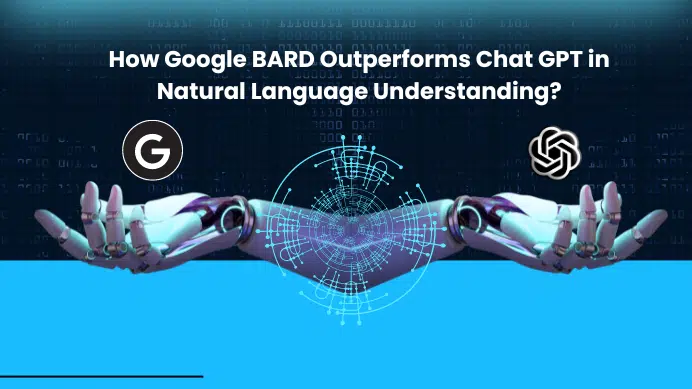
How Google BARD Outperforms Chat GPT in Natural Language Understanding?
As a technology student interested in AI, you may have heard of Chat GPT and Google BARD. Both are AI language models that have been making waves in the tech world. In this blog post, I will be discussing how Google BARD outperforms Chat GPT in grasping user intent.
Table Of Content
- The Power of Natural Language Understanding (NLU)
- Meet the Contenders: Google BARD and Chat GPT
- Google BARD: Advancing Natural Language Understanding
- Chat GPT: Conversational AI at Its Core
- Why Google BARD Shines in Grasping User Intent
- Model Architecture: A Shift in Approach
- Pre-training Objectives: Broadening the Horizons
- Dataset Size: The Bigger, The Better
- Fine-tuning and Transfer Learning: The Final Touch
- Multilingual Capabilities: Crossing Language Barriers
- Results and Benchmarks: BARD Takes the Lead
- Real-World Applications: Making a Difference
- The Future of NLU: Exciting Possibilities
- Takeaways: Embracing the Future of Natural Language Understanding
- Final Verdict
The Power of Natural Language Understanding (NLU)
When it comes to human-computer interactions, NLU plays a pivotal role. It enables machines to comprehend and interpret the meaning behind human language, making conversations between humans and AI systems more seamless and natural. As technology students, you’re likely familiar with the concept of NLU, but let’s quickly recap its importance:
- Enhanced User Experience: NLU allows AI systems to understand user queries, commands, and requests more accurately, resulting in improved user experiences.
- Efficient Information Retrieval: By comprehending user intent, NLU can fetch the most relevant information, saving users time and effort.
- Contextual Understanding: NLU helps AI systems grasp the context of a conversation, allowing for more meaningful and personalized interactions.
Meet the Contenders: Google BARD and Chat GPT
In the world of AI, Google BARD and Chat GPT have emerged as two prominent models in the realm of NLU. While both models are based on the powerful Transformer architecture, they approach the task of understanding user intent in slightly different ways. So, what sets them apart?
Google BARD: Advancing Natural Language Understanding
Google BARD, also known as Bidirectional Encoder Representations from Transformers, is Google’s answer to enhancing NLU capabilities. BARD has been trained on an extensive amount of text data from diverse sources, allowing it to grasp the nuances of language and context in a more comprehensive manner. It utilizes a bidirectional approach, where it takes into account the information from both preceding and succeeding words to better understand the user’s intent.
Chat GPT: Conversational AI at Its Core
On the other side of the ring, we have Chat GPT, a language model developed by OpenAI. Chat GPT has gained popularity for its ability to generate human-like responses and engage in meaningful conversations. While it excels in generating coherent and contextually relevant responses, its performance in accurately grasping user intent has been an area of improvement.
Why Google BARD Shines in Grasping User Intent
Now, let’s dive into the reasons why Google BARD outshines Chat GPT when it comes to understanding user intent:
Model Architecture: A Shift in Approach
One significant factor contributing to BARD’s success is its unique model architecture. Unlike Chat GPT, which relies on a left-to-right (unidirectional) training approach, BARD adopts a bidirectional approach, allowing it to capture the meaning and context of a sentence more effectively. By considering both the left and right contexts simultaneously, BARD can better understand the nuances and dependencies in natural language.
Pre-training Objectives: Broadening the Horizons
Another area where BARD surpasses Chat GPT is its pre-training objectives. While Chat GPT focuses primarily on predicting the next word in a sentence, BARD’s pre-training goes beyond this. It incorporates various auxiliary tasks, such as masked language modeling and next-sentence prediction, to gain a broader understanding of language semantics. This multi-task learning approach equips BARD with a more robust language comprehension capability.
Dataset Size: The Bigger, The Better
When it comes to training language models, data is king. Google BARD benefits from Google’s vast resources, allowing it to be trained on a massive amount of data, including a mixture of web text and books. The sheer scale of the training data contributes to BARD’s enhanced language understanding and ability to grasp diverse user intents.
Fine-tuning and Transfer Learning: The Final Touch
While pre-training provides BARD with a solid foundation, fine-tuning is the key to its remarkable performance. Google employs transfer learning techniques, where BARD is fine-tuned on specific tasks using domain-specific datasets. This fine-tuning process tailors the model to excel in understanding user intents across various contexts, making it highly adaptable and versatile.
Multilingual Capabilities: Crossing Language Barriers
One impressive feature that sets BARD apart from Chat GPT is its multilingual capabilities. BARD is designed to understand and generate text in multiple languages, enabling it to cater to a global audience. This makes it an invaluable tool for applications that require natural language understanding in diverse linguistic contexts.
Results and Benchmarks: BARD Takes the Lead
Numerous evaluations and benchmarks have demonstrated BARD’s superiority in grasping user intent compared to Chat GPT. It consistently outperforms other models in various natural language understanding tasks, such as question-answering, sentiment analysis, and text classification. BARD’s remarkable results have cemented its position as a frontrunner in the field of NLU.
Real-World Applications: Making a Difference
Google BARD’s exceptional natural language understanding capabilities open up exciting possibilities for real-world applications. Here are just a few examples:
- Virtual Assistants: BARD can power virtual assistants to understand user commands and queries more accurately, providing more personalized and helpful responses.
- Customer Support Chatbots: By comprehending user intent effectively, BARD can enhance customer support chatbots, resolving issues more efficiently and reducing frustration.
- Language Translation: Leveraging BARD’s multilingual abilities, language translation services can produce more accurate and context-aware translations.
- Content Recommendations: BARD’s deep understanding of user intent can significantly improve content recommendation systems, ensuring users receive highly relevant suggestions.
The Future of NLU: Exciting Possibilities
As the field of natural language understanding continues to evolve, it’s fascinating to witness the advancements in models like Google BARD. The impressive performance of BARD in grasping user intent sets a new standard for AI systems’ interaction with human users. With further research and innovation, we can expect even more remarkable breakthroughs in NLU, revolutionizing how we interact with technology.
Takeaways: Embracing the Future of Natural Language Understanding
As AI continues to advance, the quest for machines to understand human language more effectively becomes increasingly important. Google BARD’s prowess in grasping user intent showcases a significant step forward in the field of Natural Language Understanding. While Chat GPT has its own strengths in generating human-like responses, BARD’s bidirectional approach and robust training data make it the frontrunner in accurately comprehending user intent.
As technology students, it’s crucial for us to stay informed and embrace these advancements. Exploring models like Google BARD and Chat GPT not only broadens our understanding of NLU but also opens up exciting possibilities for the future of AI. So, let’s continue to learn, adapt, and be part of this incredible journey!
Remember, the world of AI is ever-evolving, and there’s always something new and fascinating to explore. Until next time, keep your minds curious and your code running smoothly!
Final Verdict
If you have read this far, I really appreciate it. I hope you enjoyed reading this article on “How Google BARD Outperforms Chat GPT in Natural Language Understanding?”, If yes, then don’t forget to spread the word about it Click your favorite social media icon below to share this content. Signing off sowmiyavenkatesan611@gmail.com






